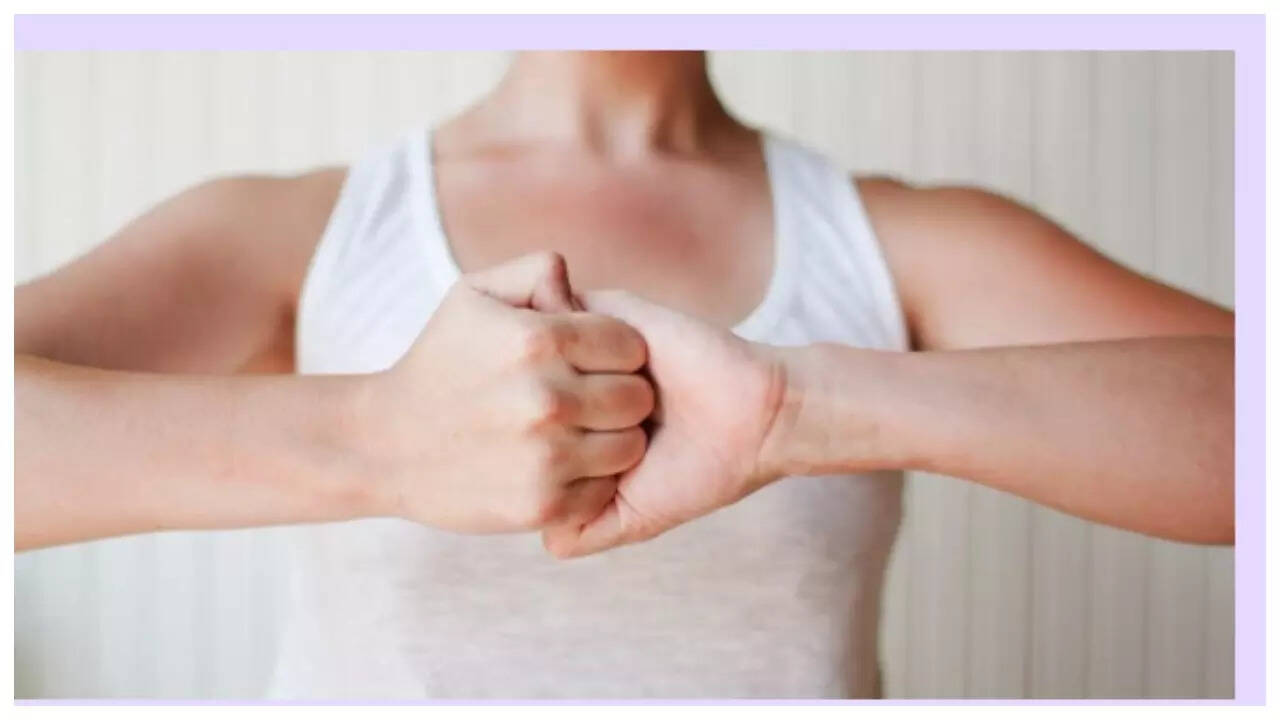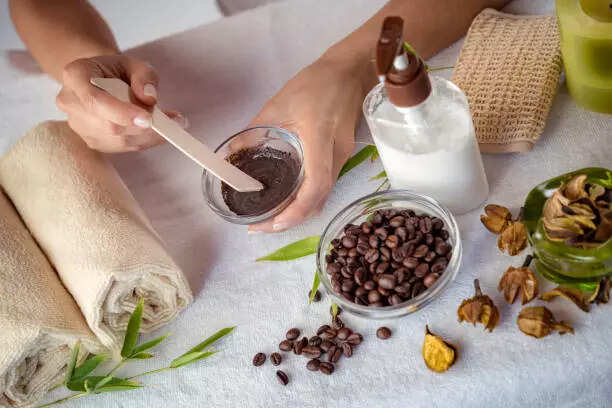Doing THIS for just 5 minutes daily can protect the heart! here’s how – Times of India

Your heart, along with the brain, is the most important organ of the body that pumps blood through your entire body. With age and poor eating habits, the heart sometimes begins to turn weak, and becomes inefficient, leading to blocked arteries that can result in a sudden heart attack. However, apart from diet and exercise, there are some other things you can do to protect your heart, out of which the Ganesh Mudra in Yoga has multiple benefits. Here is how…What is Ganesh MudraGanesh Mudra involves the practice of finger interlocking with a specific arrangement and elbow extension to form the hand position. You should perform this practice with deep breathing at chest height, to activate your heart zone, while energy flows from head to toe. The practice connects to the heart chakra (Anahata) that controls love and emotional balance and compassion. When you practice Ganesh Mudra consistently, you will break down mental and physical barriers to build inner power and endurance.

How to Perform Ganesh MudraPosition yourself comfortably and join your hands in front of your chest by forming a prayer stance.Turn your hands so the fingertips face the opposite elbows.The fingers should be linked near the heart center with the right palm directed toward the heart and left palm facing outward.Position your elbows wide to the sides while keeping them parallel to the floor.Breathe in deeply, and as you breathe out, attempt to separate your fingers while keeping them linked to feel the stretching effect.The tension should be slightly released when you inhale. The sequence should be performed six times before you reverse hand positions, to repeat the exercise another six times.Benefits for Heart HealthYour heart experiences both physical and energetic benefits through Ganesh Mudra practice:The heart muscle gains strength from the gentle finger resistance you create by separating your hands, because it activates and strengthens the heart and chest muscles.The stretch enhances blood circulation which improves heart and lung efficiency, thus delivering better oxygenation to your body and easier breathing.The practice of Ganesh Mudra unclogs energy flow in the heart chakra, thus creating emotional freedom alongside increased affection and sympathy.Through its ability to stimulate the fire element in your body, Ganesh Mudra increases digestion and energy production which are important elements for maintaining heart health.Benefits for Anxiety and StressAnxiety develops from physical tension which blocks the flow of energy in the heart and chest region. Ganesh Mudra provides several ways to address these conditions:The physical movement and slow breathing technique of Ganesh Mudra works to reduce stress while releasing tension from the chest and lungs, which normally intensify anxiety symptoms.The practice of this mudra activates inner strength which increases your confidence levels and mental courage, to tackle challenges peacefully.

Regular practice of this mudra brings positive emotional effects by clearing out sadness and depressive thoughts, as well as negative feelings.Some other benefitsGanesh Mudra removes toxic substances while enhancing lung and chest capabilities, which benefits patients with asthma.The mudra also enhances chest muscles, as well as shoulder and arm and neck muscles to improve posture and minimize spondylitis and neck pain.The practice of Ganesh Mudra activates Manipura (solar plexus) chakra to enhance digestive juice secretion and metabolic function while stimulating the fire element.The practice leads to improved mental confidence and focus, which develops inner strength and courage, while enhancing mental clarity to handle challenging situations with composure.

Relieves Pain and Tension: Through regular practice one can obtain relief from chest and shoulder pain, and minimise muscle tension which leads to complete physical comfort and relaxation.Regular practice brings mood improvement, reduces sadness and negative thoughts and depressive feelings, while it fosters peace and self-love.How Often and When to PracticeThe Ganesh Mudra provides its best results when practiced daily for 5-10 minutes, as a meditation or pranayama companion. The stretches should be repeated six times on each side.Disclaimer: The information provided in this article is for informational purposes only and should not be considered medical advice
var _mfq = window._mfq || [];
_mfq.push([“setVariable”, “toi_titan”, window.location.href]);
!(function(f, b, e, v, n, t, s) {
function loadFBEvents(isFBCampaignActive) {
if (!isFBCampaignActive) {
return;
}
(function(f, b, e, v, n, t, s) {
if (f.fbq) return;
n = f.fbq = function() {
n.callMethod ? n.callMethod(…arguments) : n.queue.push(arguments);
};
if (!f._fbq) f._fbq = n;
n.push = n;
n.loaded = !0;
n.version = ‘2.0’;
n.queue = [];
t = b.createElement(e);
t.async = !0;
t.defer = !0;
t.src = v;
s = b.getElementsByTagName(e)[0];
s.parentNode.insertBefore(t, s);
})(f, b, e, ‘https://connect.facebook.net/en_US/fbevents.js’, n, t, s);
fbq(‘init’, ‘593671331875494’);
fbq(‘track’, ‘PageView’);
};
function loadGtagEvents(isGoogleCampaignActive) {
if (!isGoogleCampaignActive) {
return;
}
var id = document.getElementById(‘toi-plus-google-campaign’);
if (id) {
return;
}
(function(f, b, e, v, n, t, s) {
t = b.createElement(e);
t.async = !0;
t.defer = !0;
t.src = v;
t.id = ‘toi-plus-google-campaign’;
s = b.getElementsByTagName(e)[0];
s.parentNode.insertBefore(t, s);
})(f, b, e, ‘https://www.googletagmanager.com/gtag/js?id=AW-877820074’, n, t, s);
};
function loadSurvicateJs(allowedSurvicateSections = []){
const section = window.location.pathname.split(‘/’)[1]
const isHomePageAllowed = window.location.pathname === ‘/’ && allowedSurvicateSections.includes(‘homepage’)
const ifAllowedOnAllPages = allowedSurvicateSections && allowedSurvicateSections.includes(‘all’);
if(allowedSurvicateSections.includes(section) || isHomePageAllowed || ifAllowedOnAllPages){
(function(w) {
function setAttributes() {
var prime_user_status = window.isPrime ? ‘paid’ : ‘free’ ;
var geoLocation = window?.geoinfo?.CountryCode ? window?.geoinfo?.CountryCode : ‘IN’ ;
w._sva.setVisitorTraits({
toi_user_subscription_status : prime_user_status,
toi_user_geolocation : geoLocation
});
}
if (w._sva && w._sva.setVisitorTraits) {
setAttributes();
} else {
w.addEventListener(“SurvicateReady”, setAttributes);
}
var s = document.createElement(‘script’);
s.src=”https://survey.survicate.com/workspaces/0be6ae9845d14a7c8ff08a7a00bd9b21/web_surveys.js”;
s.async = true;
var e = document.getElementsByTagName(‘script’)[0];
e.parentNode.insertBefore(s, e);
})(window);
}
}
window.TimesApps = window.TimesApps || {};
var TimesApps = window.TimesApps;
TimesApps.toiPlusEvents = function(config) {
var isConfigAvailable = “toiplus_site_settings” in f && “isFBCampaignActive” in f.toiplus_site_settings && “isGoogleCampaignActive” in f.toiplus_site_settings;
var isPrimeUser = window.isPrime;
var isPrimeUserLayout = window.isPrimeUserLayout;
if (isConfigAvailable && !isPrimeUser) {
loadGtagEvents(f.toiplus_site_settings.isGoogleCampaignActive);
loadFBEvents(f.toiplus_site_settings.isFBCampaignActive);
loadSurvicateJs(f.toiplus_site_settings.allowedSurvicateSections);
} else {
var JarvisUrl=”https://jarvis.indiatimes.com/v1/feeds/toi_plus/site_settings/643526e21443833f0c454615?db_env=published”;
window.getFromClient(JarvisUrl, function(config){
if (config) {
const allowedSectionSuricate = (isPrimeUserLayout) ? config?.allowedSurvicatePrimeSections : config?.allowedSurvicateSections
loadGtagEvents(config?.isGoogleCampaignActive);
loadFBEvents(config?.isFBCampaignActive);
loadSurvicateJs(allowedSectionSuricate);
}
})
}
};
})(
window,
document,
‘script’,
);
[title_words_as_hashtags



